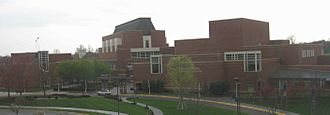Clarice Smith Performing Arts Center facts for kids
Quick facts for kids The Clarice Smith Performing Arts Center |
|
|---|---|

A front view of the Clarice in 2006
|
|
| General information | |
| Status | The largest single building ever constructed by the State of Maryland |
| Type | Performance venue and academic building |
| Location |
|
| Coordinates | 38°59′27″N 76°57′02″W / 38.99083°N 76.95056°W |
| Named for | Clarice Smith |
| Completed | 2001 |
| Design and construction | |
| Architect | Moore Ruble Yudell |
The Clarice Smith Performing Arts Center, often called The Clarice, is a huge building at the University of Maryland, College Park. It's a place where you can see amazing shows and learn about music, dance, and theater.
This big building opened in 2001. It has six different stages for performances. It's also home to the University of Maryland's School of Music and the School of Theatre, Dance, and Performance Studies. There's even a special library for performing arts inside!
Every year, The Clarice hosts many shows. You can watch music, dance, and theater performances. These shows feature both famous visiting artists and talented students and teachers from the university. In 2014, the center started calling itself "The Clarice." They also began a fun event called the NextNOW Festival. This festival has many free events at the start of the fall school year.
The Clarice is located on the northern side of the University of Maryland campus. It's right across the street from Capital One Field at Maryland Stadium.
History of The Clarice
The Clarice Smith Performing Arts Center is named after Clarice Smith. She is a visual artist. Her late husband, Robert H. Smith, was a very generous person. He gave a lot of money to support art, business, and other important projects.
Robert H. Smith went to the University of Maryland. He made big donations to The Clarice Smith Performing Arts Center. He also supported the Robert H. Smith School of Business.
The Clarice was first planned as a place for students to learn about performing arts. But during its planning, the idea grew. It became a place not just for learning, but also for showing performances by touring artists. It also started creating programs for the people of Prince George’s County, Maryland. This is where the university is located.
Building and Design
The Clarice Smith Performing Arts Center is a very large building. It covers about 17 acres of land. It was the biggest single building ever built by the State of Maryland. The first cost to build it was $130 million. This money came from the State of Maryland, the University of Maryland, and Prince George’s County.
The building was designed by famous architects Moore Ruble Yudell. Many other experts helped with the design. They made sure the sound was perfect and the theaters worked well. The construction was done by Turner Construction Company.
Most of the six performance spaces can be reached from the Grand Pavilion. This is the main lobby of The Clarice. One space is at the top of the stairs in the Upper Pavilion.
Performance Spaces
- Grand Pavilion
- This is the main lobby and a large open space.
- Dekelboum Concert Hall
- This hall has 962 seats.
- It's designed for concerts and musical performances.
- Ina and Jack Kay Theatre
- This theater has 626 seats.
- It's used for big shows with many actors and large sets.
- Joseph and Alma Gildenhorn Recital Hall
- This is a smaller, beautiful theater with 297 seats.
- It's made to make music sound amazing.
- Dance Theatre
- This theater has 207 seats.
- It has special wooden floors that are good for dancing.
- It's used for dance shows, rehearsals, and workshops.
- Robert and Arlene Kogod Theatre
- This is a "black box" theater with 156 seats.
- It's very flexible and can be used for many different types of performances.
- It also hosts meetings and parties.
- Cafritz Foundation Theatre
- This is another "black box" theater with 86 seats.
- It's used for performances, talks, meetings, and special events.
- Leah H. Smith Lecture Hall
- This hall often hosts student performances.
- It's also used for free events like talks with performers.
- Sometimes, it's even used as a classroom for university courses.

